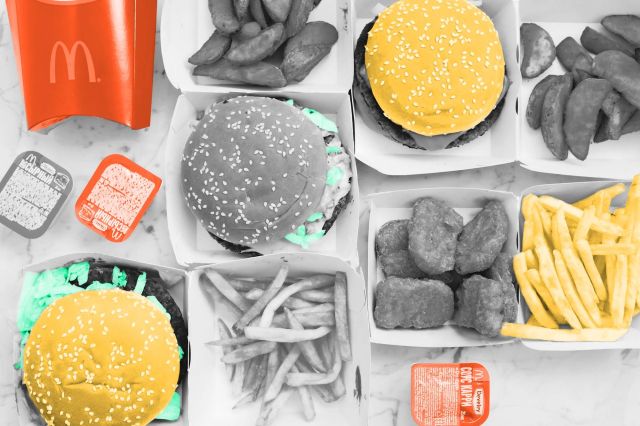
McDonald’s Is the World’s Largest Toy Distributor
Since the creation of the Happy Meal in 1979, McDonald’s has leapfrogged industry giants such as Hasbro and Mattel to become the world’s largest toy distributor. Early Happy Meal toys included stencils and spinning tops, though the trinkets were later designed as part of advertising campaigns to promote family movies, like 1989’s The Little Mermaid. All told, McDonald’s distributes 1.5 billion toys worldwide each year. As part of a recent effort to be more environmentally conscious, the company has pledged to largely phase out plastic toys in Happy Meals, and vowed to work to provide kids with plant-based or recycled toys instead.

One McDonald’s in Arizona Features Turquoise Arches
Golden arches may be synonymous with McDonald’s, but they’re nowhere to be found at one location in Sedona, Arizona. Due to a local law that prevents buildings from infringing on the region’s natural beauty, this McDonald’s instead features turquoise arches. City officials determined the gold would clash with the surrounding red rocks, whereas the turquoise was a more appropriate hue. Other unique color schemes at McDonald’s around the world include white arches at Paris and Belgian locations, as well as a big red “M” in place of the traditional yellow at one Rocklin, California, joint.

McDonald’s Used to Sell Hot Dogs and Barbecue
The men who founded the chain that would become McDonald’s — Dick and Mac McDonald — opened the fast food giant as a modest California hot dog stand in 1937. They would later pivot to a different food: On May 15, 1940, they opened McDonald’s Bar-B-Que in San Bernardino. The foray into BBQ was somewhat short-lived, however, because by October 1948 the brothers had realized that most of their profits came from selling burgers. The pair decided to establish a simple menu featuring hamburgers, potato chips, and orange juice, and added french fries and Coke a year later. The franchise was licensed to Ray Kroc in 1954, who transformed McDonald’s into the chain we know today.
More Interesting Reads

Coca-Cola Tastes “Better” at McDonald’s
No, it’s not your imagination, Coke actually does taste different — and many would say better — at McDonald’s restaurants. This is largely due to the way it’s packaged. While the actual flavoring is identical to other restaurants, McDonald’s gets its Coke syrup delivered in stainless steel tanks instead of the more common plastic bags, which in turn keeps the syrup fresher. McDonald’s also filters its water prior to adding it to the soda machines, and calibrates its syrup-to-water ratio to account for melting ice. In addition, McDonald’s utilizes wider straws than normal, allowing more Coke to “hit your taste buds,” according to the company.

Queen Elizabeth II Technically Owned a McDonald’s
While she was never actually there whipping up McFlurries, Britain’s former monarch technically owned a branch located in Oxfordshire, England, atop the Crown Estate, which is land belonging to the royal family. The queen used to own a second location in Slough, but sold the land in 2016. The location is truly fit for royalty, with leather couches and table service, plus a menu that includes English breakfast tea and porridge. This is not the only royal association with McDonald’s: Princess Diana used to frequently take her sons William and Harry to McDonald’s, despite the fact that they had access to a personal chef.

A McDonald’s Superfan Has Eaten Over 34,000 Big Macs
In a tradition that first began over 50 years ago on May 17, 1972, Wisconsin’s Don Gorske has consumed upwards of 34,000 Big Macs — and counting. While Gorske originally ate, on average, a whopping (no Burger King pun intended) nine Big Macs per day, he has since scaled back to about two a day. Gorske claims that in those 50 years he has only missed eating a Big Mac on eight days. The previous record for Big Macs eaten in one lifetime was 15,490, a number that Gorske smashed back in 1999 and has been dwarfing ever since.

McDonald’s Sells 75 Burgers Per Second
According to its own training manual, McDonald’s locations combined sell more than 75 hamburgers per second. The average hamburger is cooked and assembled in 112 seconds, whereas a Quarter Pounder takes a lengthier but still lightning-quick 180 seconds to prepare (assuming there are no other orders being worked on at the same time). McDonald’s produces and sells so many burgers that it had already sold its 100 millionth by 1958. In 1963, it sold its billionth burger live on TV during an episode of Art Linkletter’s variety show. The chain officially stopped keeping track in 1993, when it updated its signs to say “Over 99 Billion Served.”











